Author: Sye Yehya
This article is a complete buying guide to Tiffany lamps, their history, manufacture, types, how to keep them looking their best and how they can add a wow factor to any room in which they are installed.
10-20 Minute Read – Jump To:
- A Brief History of Tiffany Lamps
- How Tiffany Lamps Are Made
- Tiffany Styles Explained
- Where and How to Use Tiffany Lamps
- Tiffany Lamp Comparison Table
- Tiffany Lamp Buying Checklist
- Why Are Tiffany Lamps Expensive?
- Caring for Your Tiffany Lamp
- Frequently Asked Questions
- Conclusion
A Brief history of Tiffany lamps
Recent information suggests that the very first Tiffany lamp was made around 1895 and designed by an artist named Clara Driscoll, who was the director of Tiffany studios in New York. They specialised in the selection, colour and cutting of glass to be used in their own shade designs. Clara Driscoll is believed to be the creator of the very first Daffodil designed Tiffany table lamp and credited with the classic Wisteria, Dragonfly and Peony designs that continue to this day.
Louis Comfort Tiffany started business specialising in the design of leaded glass windows as part of his interior design business. He began making leaded stained glass shades for light fittings of such quality and for so long that the whole style range of this shade became known as Tiffany lamps.
At the beginning Tiffany lamp designs were influenced by nature and considered to be of the Art Nouveau style. They stayed in fashion throughout the Art Deco period where geometric designs became the design of choice. It’s testament to all of the designs that they remain stylish, current and vibrant to this very day.
The phrase Tiffany lamp has come to mean any light fitting with a Tiffany style shade manufactured by soldering pieces of stained glass into a design.
How Tiffany lamps are made
All Tiffany lamps are made in the same way by hand and cannot be manufactured by machine or automated in any way.
The design stage
Each design is usually created by an artist. Once the design has been approved, a full sized model replica of the shade is made, usually from wood, although cardboard and plastic are used today. The model is then overlaid with thick paper or cloth soaked in resin or glue to stiffen it and the design overlaid onto it. Once dry it is removed and each piece is cut out, numbered and used as a template for each piece of glass that will be used in the manufacture.
The Manufacturing Process
- Each piece of glass is hand cut, edged in copper foil, and arranged on a wax covered mould.
- The pieces are then hand soldered together forming the shade.
- Heat is applied to melt the wax allowing the shade to be removed from the mould.
A good quality hand crafted glass Tiffany lamp will feel waxy and need cleaning off before first use. This is not a fault or production issue; rather it is a hallmark of traditional craftsmanship.
Tiffany Styles Explained
There are six main design style categories, nature (Traditional), geometric (Art Deco), studio (Tiffany), Mackintosh inspired, Art Nouveau and Mission Style. I will deal with each in turn and give examples of each style.
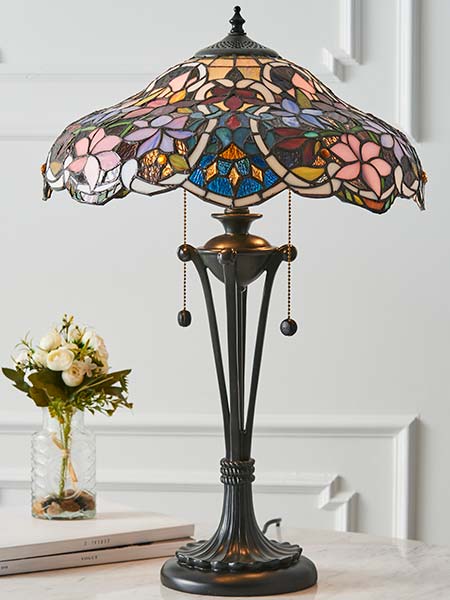
Nature
The nature category is traditional and one of the first styles created and includes floral designs, dragonfly and butterfly creations that can sometimes be very complex and labour intensive.
Just take a look at this beautiful large 2 light Sullivan Tiffany table lamp with it’s beautiful floral design. Now, imagine how long it takes to design, select, cut, assemble and hand solder every piece together to create this work of art.
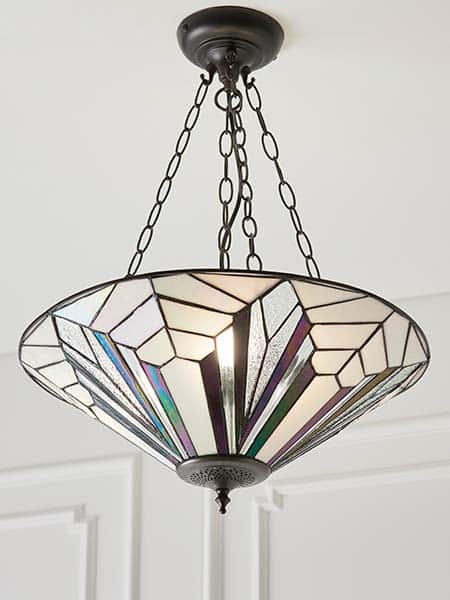
Geometric
Geometric designs became fashionable during the Art Deco period. They are often symmetrical, incorporating a pattern that is repeated throughout the design. Some are very simple and use different striking coloured glass to create the effect, whilst others are more complex and vibrant.
One thing that always sets this design apart from others is the use of geometric shapes and striking design. This Astoria 3 light inverted Tiffany ceiling pendant is an excellent example.
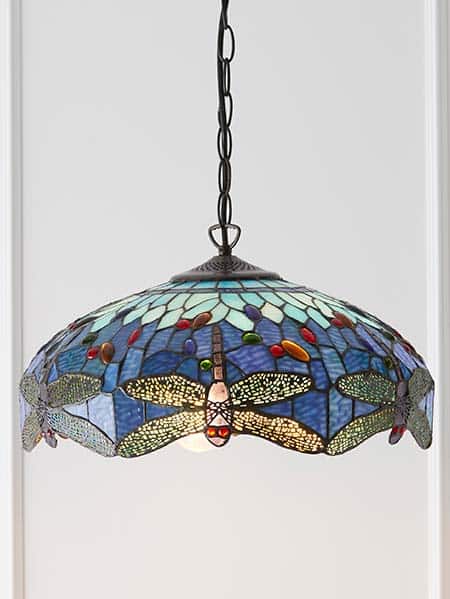
Studio
This category is designated to the types of designs that were originally crafted by the Tiffany studio. The best known of these is the Dragonfly design that is still available today in blue, red, green and beige. This classic style features different coloured backgrounds inset with glass jewels and a border of dragonfly wings. The dragonfly body is always highlighted and the eyes picked out with sparkling glass beads.
This 3 lamp Blue Dragonfly Tiffany pendant is a fine example. Just look at the amount of separate pieces of glass and think of the work involved in creating this stunning ceiling light.
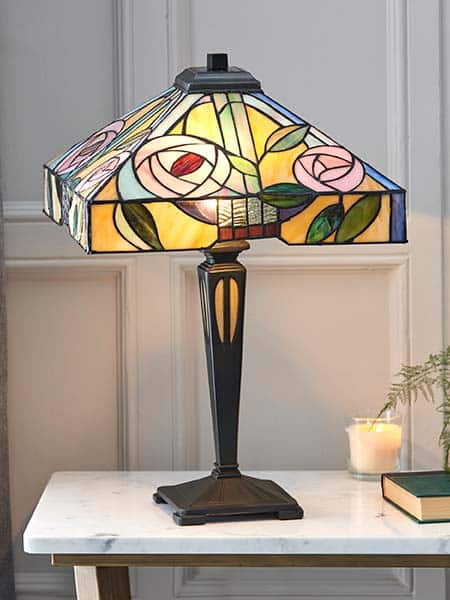
Mackintosh Inspired
This style is inspired by the Charles Rennie Mackintosh rose motif that most of us recognise. It usually features an uncluttered nature influenced background with a more prominent rose. This style sometimes features other animals from nature such as doves, butterflies and damselflies. It is usually more angled and sometimes feature a drop skirt around the edge.
The Beautiful Willow rose design shows a typical Mackintosh design incorporated into a stunning 2 light table lamp.
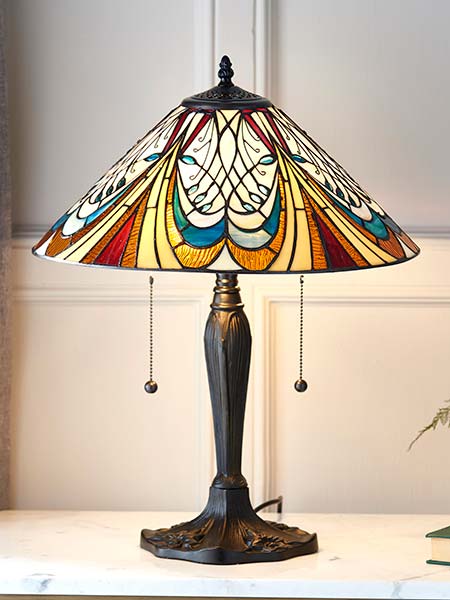
Art Nouveau
The Art Nouveau period ran from about 1890 to around 1915. Had it not been for the First World War, it would likely have continued for much longer. Characterised by intricate linear designs and flowing curves based on natural forms. This was a very stylish period in history that predated the Art Deco Era.
Hector medium table lamp shown here is a great example of just how stunning Art Nouveau designs can be.
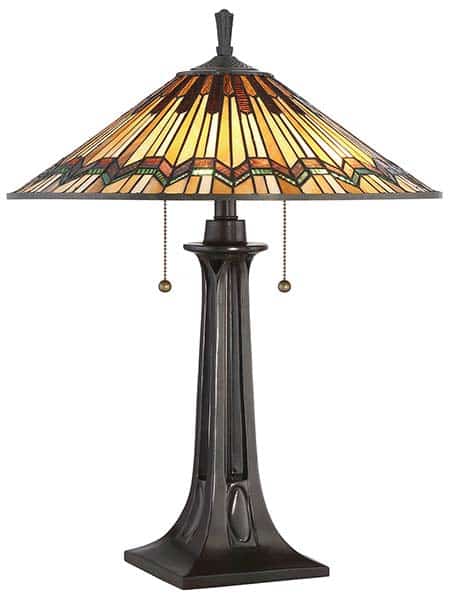
Mission Style
The Mission Style is decorative and began in the late 1800’s, following on from the Arts and Crafts Movement. They are distinguished by their use of straight lines and geometric patterns much like the Art Deco style.The Mission style will never include floral elements or elements from nature.
The mission style doesn’t shout look at me from the rooftops but attracts attention wherever it’s placed. Very Popular in the USA, this style is now becoming more common in the UK. The Alcott Mission style 2 light Tiffany table lamp is a fine example using earthy tones and straight lines.
Different uses
Tiffany lamps are manufactured to cover the entire house, in different sizes and types. There are some ceiling lights as large as 1m in diameter and some table lamps as small as 145mm across. Everyone has somewhere that would benefit from the style and grace of a Tiffany light fitting.
Where and How to Use Tiffany Lamps
Tiffany Ceiling Lights
Tiffany pendant lights are mounted on the ceiling and hang down to illuminate the room. They are usually the main light source and can be facing downwards or upwards. The downward facing shades cast the light directly into the room whilst the shade will sparkle as the light highlights the design. It is important to remember that the lower the pendant, the smaller the spread of light. Upward facing pendants shine little or no light downwards and bounce most of the light off the ceiling and back into the room for a softer more ambient glow. Pendants are supplied with chain or rod suspension in a variety of finishes but usually black or antique.
Flush and semi-flush Tiffany lights are designed for rooms that have a limited ceiling height and are used where there is insufficient drop to house a pendant. They feature the same stunning designs but are typically only 200 – 450mm in height.
Wall Lights
Tiffany wall lights are fantastic in any room. It’s almost as if you have works of art decorating the wall and when they are switched on they are a beauty to behold. They are almost always in the style of a wall washer, with a mounting bracket and the shade fixed over. The light is then directed up the wall and onto the ceiling creating a soft background light. I have never seen a switched Tiffany wall light, so that’s something to bear in mind when shopping for one.
Table and floor lamps
A Tiffany table lamp is a thing of beauty and will always give you pleasure especially when it’s lit. They all feature downward facing shades and are available in every style to suit almost every taste. The important thing to remember is that unlike some table lamps, little or no light is projected into the room through the shade. The shade is the feature here and the light output is secondary, although they will all give a warm background light. Tiffany table lamps are decorative but can be used as a reading light if placed high on a sideboard, yet remain pieces of art to be admired. The table lamps sit on a resin, cast metal or solid brass base in a range of finishes.
Tiffany floor lamps are either the traditionally styled standard lamp, with a downward facing shade sitting on top or as an uplighter. The floor lamp will project the light downwards and give a pool of light below and the shade will illuminate and attract the eye. The uplighter will also sparkle when lit but bounces the light off the ceiling to create a wider, softer spread of light. The floor lamps sit on a cast metal base, finished in black, bronze or antique depending on style.
Why are Tiffany Lamps Expensive?
The more complex designs contain hundreds of pieces of art glass and take many hours to make. Each piece of glass has to be hand-cut and hand-polished before being edged in foil and soldered into place. The more time it takes, the higher the labour cost. Not all Tiffany lamps are of the same quality. High quality art glass is more expensive than mass produced float glass and some of the cheapest Tiffany style lamps aren’t made from glass at all but plastic.
A resin base is much cheaper to produce than a cast metal or cast brass base. This is reflected in the overall cost of a table lamp.
Caring for Your Tiffany lamp
- When you first receive your lamp it will have a thin coating of wax that was used in the manufacturing process. This simply needs to be wiped off with a weak solution of water and washing-up liquid on a clean cloth, then dried off with a soft clean cloth.
- They need minimal care to keep them looking at their best. A weekly dust over will keep the glass free of particles, which may impede the effect if allowed to build up. A wipe down with a damp cloth twice a year is all that is required and will keep it looking radiant and performing at its best.
- A simple tip that will enhance the colours is to always use clear bulbs as opposed to pearl or opal lamps. A clear bulb will create that sparkle effect through the coloured translucent glass of the table lamp. The clear bulb should also be dusted once in a while to get the best out of them.
- Never use an abrasive cleaner or any cleaner containing any solvent or chemical on a Tiffany glass shade.
Tiffany Lamp Buying Checklist
- What room is the lamp for? (e.g. living room, bedroom, hallway)
- Which style suits your décor? (Nature, Geometric, Studio, etc.)
- Do you want a table, floor, ceiling, or wall lamp?
- Is the lamp size appropriate for the space or table surface?
- Will it be used for ambience or task lighting (e.g. reading)?
- Do you prefer a plug-in model or a hardwired fitting?
- Will you use LED or smart bulbs?
- Is the lamp made of real stained glass and copper foil?
- What is your budget?
- Do you need matching pieces for other rooms or furniture?
- Do you require dimming capabilities or a specific bulb fitting?
Frequently Asked Questions
Q) How can I tell if a Tiffany lamp is authentic or a reproduction?
A) Genuine Tiffany lamps, designed by Louis Comfort Tiffany, are antiques and extremely rare. Almost all “Tiffany-style” lamps available today will be inspired by his designs rather than originals. Look for stained glass, copper foil between each glass piece, quality soldering, and a substantial metal base. Many reputable modern makers, for example Interiors 1900, produce authentic reproductions using traditional techniques.
Q) What size Tiffany lamp do I need?
A) As a general guide:
- Table lamps: The shade should be no wider than the table surface. Smaller shades will suit bedside tables, while larger shades are ideal for bigger side tables.
- Floor lamps: Used for reading areas or to add height in corners. Aim for a height of around 1.5m – 1.6m.
- Ceiling pendants: Over dining tables, you should look for a lamp with a diameter around two thirds of the table width and they should be hung around 0.75m – 1m above the table top.
Q) Are Tiffany lamps compatible with LED bulbs and can they be dimmed?
- Yes! Most modern Tiffany lamps use standard E14, E27 or B22 lamp holders, so LED bulbs are perfect. You should select dimmable LEDs for added control, and make sure your dimmer switch is LED compatible. These are generally known as trailing edge dimmers. This allows you to maintain the warm light of stained glass while saving energy and extending bulb life.
- Note: If you are looking to dim Tiffany floor and table lamps, then speak to your electrician about installing an in-line dimmer switch on the cable.
Q) Can smart bulbs be used with Tiffany lamps?
A) Yes, they can. Tiffany lamps can work with smart bulbs, (ensure that the bulb shape fits inside the shade). Just pair it with your home hub or app for voice control or scheduling. This is a great option for hard to reach floor lamps or bedside lighting.
Q) What is the typical price range for a Tiffany style lamp?
- Tiffany table lamps: £70 – £500+
- Floor lamps: £170 – £500+
- Ceiling pendants: £100 – £500+
Factors including hand-cut art glass, brass bases, and British made designs can increase cost, but also provide long-term quality.
Q) Do Tiffany lamps come with a warranty?
A) All of our Tiffany style products are backed by a minimum 2 year guarantee. Check the product page for details of the warranty offered as some brands offer longer coverage. We also offer a 30day hassle free returns policy and expert after sales support if you ever need help with any issue and for peace of mind.
Q) How long do Tiffany lamps last?
Tiffany lamps can last a lifetime. The stained glass won’t fade and the metalwork is built to last. You will only need to change the bulbs over time.
Conclusion
Always buy the best quality you can afford, in a style and of a size in keeping with your room and overall theme.
There is an overwhelming choice of Tiffany lamps available for every room in your house. Carefully chosen, your light fixtures can be works of art in their own right and direct the eye to wherever they are installed. They can brighten the gloomiest corner and transform the darkest alcove into a thing of beauty. If you don’t have a central ceiling light or can’t add one easily then consider a Tiffany floor lamp that will draw the eye upwards and add drama and beauty.
This is not a battle of style versus function as it fulfils both perfectly. You too have the opportunity to discover the true fascination of colour, nature and light through the beauty of Tiffany lamps.
This buying guide has been written to assist you when selecting your Tiffany lamp from our comprehensive Tiffany lighting range that can be viewed by following the highlighted link. They include pendants, table lamps, floor lamps and wall lights in matching ranges. They are all hand crafted using the traditional copper foil and solder techniques that have been in use for over a hundred years. Most of the lamps we supply feature hand-cut and hand-polished pieces of highest quality art glass, whilst some feature machine cut and polished stained glass.
The light created through a Tiffany shade is captivating; it seems to create a magical atmosphere of warmth peace and illusion. A Tiffany lamp creates a feature that no other type of lighting can create. No matter how long you own a Tiffany lamp, it will remain as captivating and inviting as the day you first set eyes on it.
Ready to find your perfect Tiffany Style lamp? Explore our full collection here, including table, floor, ceiling and wall lights.
Whatever you decide upon we are here to help. If you require any further information or clarification on anything to do with Tiffany lamps, please contact us and we will be happy to assist you.


